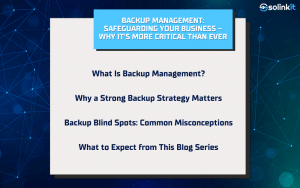In today’s interconnected world, businesses rely heavily on digital infrastructure to operate efficiently. Therefore, the importance of network device security cannot be overstated. From routers and switches to firewalls and access points, network devices form the backbone of modern communication systems. These devices are prime targets for cyber attacks. Therefore, organizations must prioritize security measures. This includes changing default settings. In this blog, we’ll explore the reasons why network device security and altering default configurations are critical in today’s digital landscape.
Unveiling the Vulnerability of Default Settings
Default Configurations as Security Vulnerabilities
Network devices arrive with default configurations precisely crafted by manufacturers to expedite the setup process. While designed for convenience, these pre-established settings inadvertently open a Pandora’s box of security vulnerabilities. Savvy hackers lurk in the shadows, keenly attuned to the common default settings embraced by manufacturers. Armed with this knowledge, they brazenly exploit these vulnerabilities. They use default configurations as potent weapons to breach organizational defenses. This allows them to gain illicit access to network devices.
Default Credentials: A Ticking Time Bomb
The vulnerability stems from the widespread use of default username and password combinations on numerous routers and switches. This practice lies at the core of the issue. Furthermore, these standardized credentials, if left unaltered by administrators, serve as a proverbial golden key. Consequently, they grant cybercriminals unfettered access to network devices. The consequences of such oversight are dire, with the potential for data breaches, network infiltrations, and a catalog of other nefarious activities looming ominously on the horizon. Neglecting to recalibrate these default settings casts a long shadow of compromised security over organizations. Consequently, such negligence leaves them vulnerable to exploitation, endangering the sanctity of their digital infrastructure. Therefore, it’s imperative for organizations to address this issue to mitigate risks and ensure the safety of their systems.
Mitigating Common Threats: A Proactive Approach to Fortifying Network Security
Customizing Default Settings for Enhanced Security
In the ever-evolving landscape of cybersecurity, proactive measures are indispensable. They are essential for organizations seeking to fortify their digital defenses against a host of threats. Among these measures, the customization of default settings emerges as a linchpin. It plays a crucial role in mitigating common security vulnerabilities that lurk within network devices. By tailoring configurations to align with specific security requirements and industry best practices, administrators can erect formidable barriers against attacks. Additionally, this proactive approach bolsters the resilience of its network infrastructure, enhancing its ability to withstand potential threats. Consequently, organizations can better safeguard their sensitive data and protect against potential breaches.
A cornerstone of this proactive approach lies in strategic recalibration, aiming to diminish the attack surface and thwart potential exploits. By adjusting default settings strategically, organizations can bolster their defenses against cyber threats. This proactive measure helps fortify security and mitigate the risk of vulnerabilities being exploited. Administrators have access to a potent arsenal of customization options. These options range from disabling unnecessary services and ports to implementing robust access control lists (ACLs). Additionally, administrators can enable encryption protocols such as WPA2 for wireless networks. Each adjustment serves as a wall against unauthorized access and eavesdropping, erecting formidable barriers that deter would-be intruders from penetrating the network’s defenses.
Implementing Robust Firmware Management Practices
Moreover, the diligent application of firmware updates and security patches constitutes a vital component of this proactive strategy. By remaining vigilant and proactive in their patch management practices, organizations can effectively neutralize known vulnerabilities and preemptively thwart exploitation by malicious actors. Regular updates serve as a proactive line of defense, fortifying network devices against emerging threats and ensuring the integrity and resilience of the network infrastructure.
In essence, the customization of default settings represents a proactive paradigm shift in cybersecurity. It empowers organizations to anticipate and address potential vulnerabilities before they can be exploited. The mitigation of common threats through this approach enables proactive protection against cyberattacks. By embracing this proactive approach, organizations can fortify their defenses, mitigate risks, and uphold the sanctity of their digital assets in an increasingly hostile digital landscape.

Strengthening Defense-in-Depth: Fortifying Network Security through Layered Protection
Customized Default Settings: Reinforcing Cyber Defenses
In the perpetual arms race against cyber threats, a robust defense-in-depth strategy stands as the bulwark safeguarding organizational assets from malevolent actors lurking in the digital shadows. At the heart of this multi-layered approach lies the strategic customization of default settings, serving as a linchpin that fortifies the network’s defenses and augments the efficacy of existing security measures such as firewalls, intrusion detection systems (IDS), and endpoint security solutions.
Embarking on the journey of customizing default settings enhances the security posture of organizations by adding an extra layer of protection to their network infrastructure. Additionally, this augmentation strengthens their resilience against the constantly evolving threat landscape. Embracing this proactive stance empowers organizations to strengthen their digital ramparts, safeguarding against a plethora of external threats. Among these threats are sophisticated cyber attacks and opportunistic exploits that target vulnerabilities in the network’s defenses. Consequently, by taking proactive measures, organizations can effectively defend their networks and mitigate the risk of security breaches.
Customizing Default Settings for Enhanced Security
Furthermore, the strategic customization of default settings serves as a bulwark against internal risks, mitigating the perils posed by accidental misconfigurations and insider threats. Organizations strengthen their security posture by aligning configurations with security best practices and industry standards. This ensures resilience against both external assaults and internal vulnerabilities. Such measures safeguard the integrity of the network infrastructure.
In essence, the augmentation of defense-in-depth through the customization of default settings represents a proactive paradigm shift in network security, empowering organizations to cultivate a culture of resilience and fortitude in the face of emerging threats. By embracing this multi-faceted approach, organizations fortify their defenses. They also mitigate risks and uphold the sanctity of their digital assets. This occurs in an ever-changing cyber landscape characterized by relentless adversaries. Additionally, this landscape features evolving attack vectors.
Compliance and Regulatory Imperatives: Navigating the Complex Terrain of Data Protection
Customizing Default Settings for Compliance
In today’s hyper-regulated business landscape, adherence to stringent industry standards and data protection regulations is no longer a matter of choice but a fundamental requirement for organizations across diverse sectors. Central to achieving compliance with these mandates is the meticulous customization of default settings within network devices—a pivotal step in safeguarding sensitive data and upholding the integrity of organizational operations.
The regulatory landscape is rife with mandates such as the General Data Protection Regulation (GDPR), Payment Card Industry Data Security Standard (PCI DSS), and Health Insurance Portability and Accountability Act (HIPAA), each imposing rigorous requirements on organizations to safeguard the privacy and security of sensitive information. Changing default settings is frequently considered a fundamental requirement for complying with these regulations. It serves as a proactive step to reduce vulnerabilities and strengthen network defenses against unauthorized access or disclosure. This practice is essential for maintaining compliance standards and safeguarding sensitive data. Implementing such changes demonstrates a commitment to security and regulatory adherence.
Proactive Compliance: Customizing Default Settings for Security and Regulation
Regulatory bodies and industry watchdogs scrutinize organizations’ adherence to established security guidelines, expecting proactive measures to secure network infrastructure and protect sensitive data from potential breaches. Consequently, failure to customize default settings and align network configurations with regulatory mandates can have far-reaching consequences. These include severe penalties, legal liabilities, and irreparable reputational damage for non-compliant entities.
Navigating the complex terrain of compliance and regulatory imperatives requires organizations to adopt a proactive stance toward network device security. They must recognize the critical role that customization of default settings plays in achieving regulatory compliance. Customization not only ensures adherence to regulations but also contributes to preserving stakeholder trust. Embracing this proactive approach is essential for organizations to effectively safeguard sensitive data and uphold integrity in a regulated business environment. By embracing this proactive approach, organizations can not only mitigate the risk of regulatory sanctions but also demonstrate a commitment to safeguarding sensitive data and upholding the highest standards of integrity and accountability in an increasingly regulated business environment.
Conclusion: Elevating Network Security in the Digital Age
In today’s digital landscape, customizing default settings in network devices is crucial for organizational security and stakeholder trust. This proactive measure not only ensures compliance but also helps mitigate vulnerabilities and strengthen defenses against cyber threats. Aligning network configurations with regulatory standards and best practices demonstrates a commitment to data security and regulatory compliance. Administrators play a key role in continually reviewing and adapting device settings to address emerging threats. Investing in employee training fosters a culture of cybersecurity, empowering personnel to recognize and mitigate risks. Organizations that embrace proactive network security protect critical assets and navigate digital challenges with confidence.






